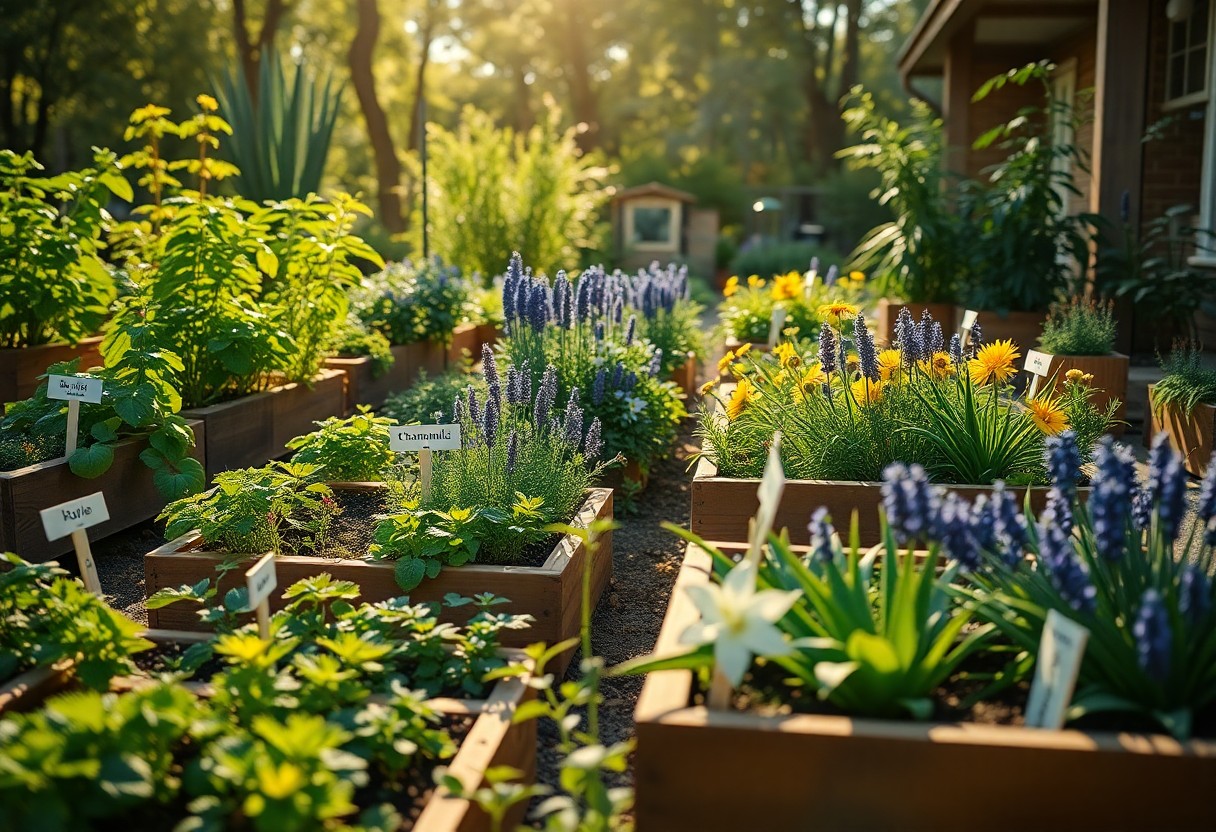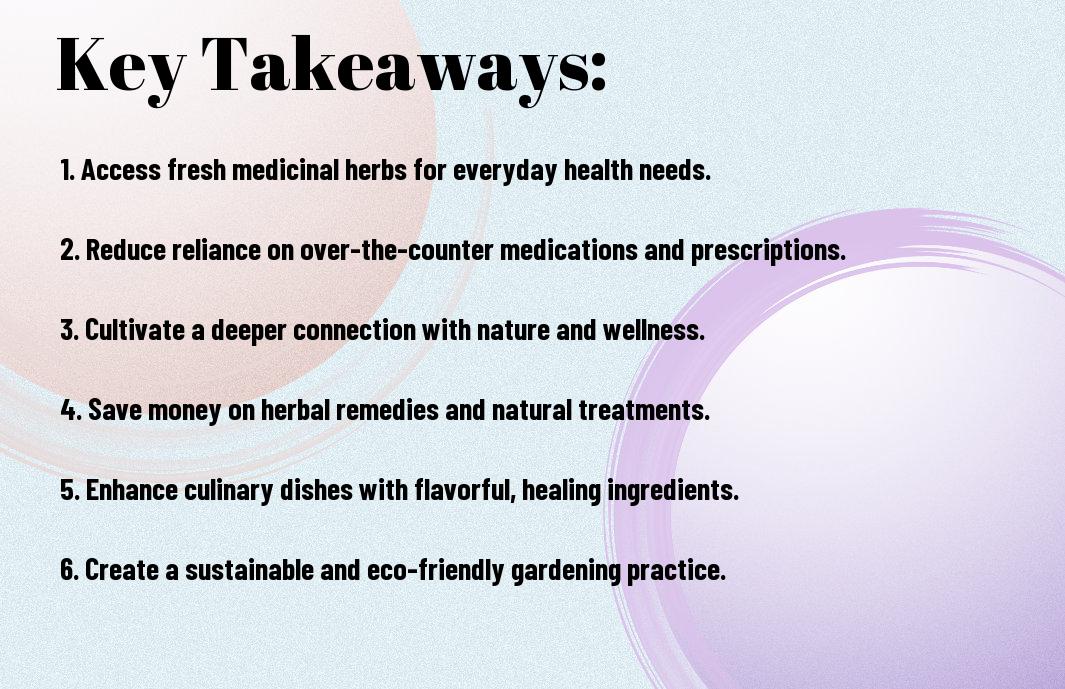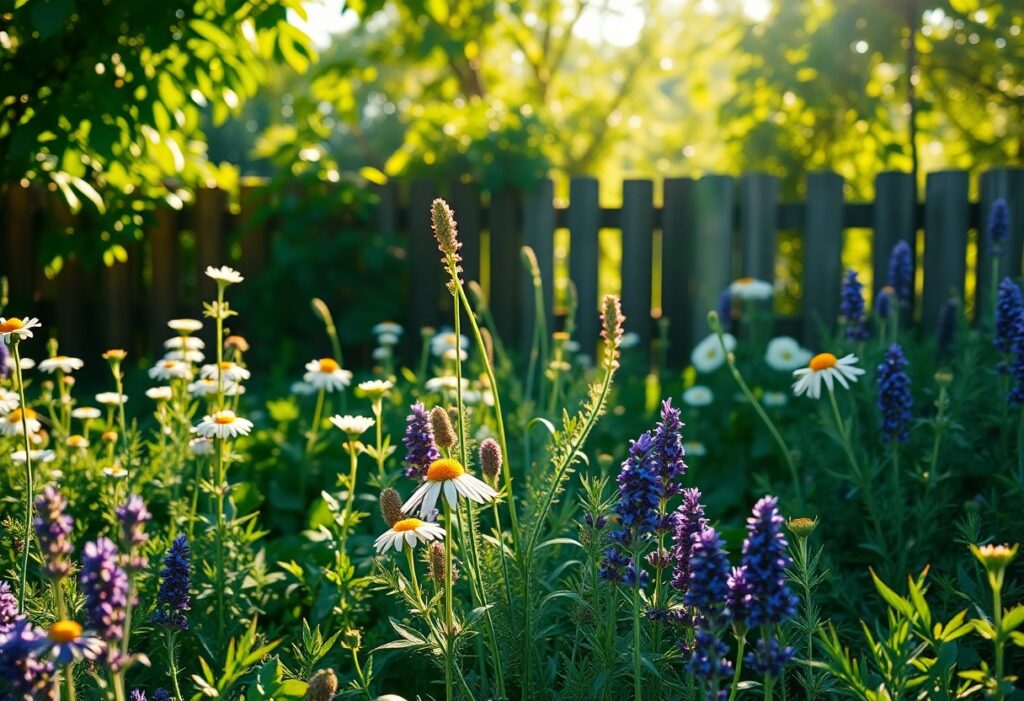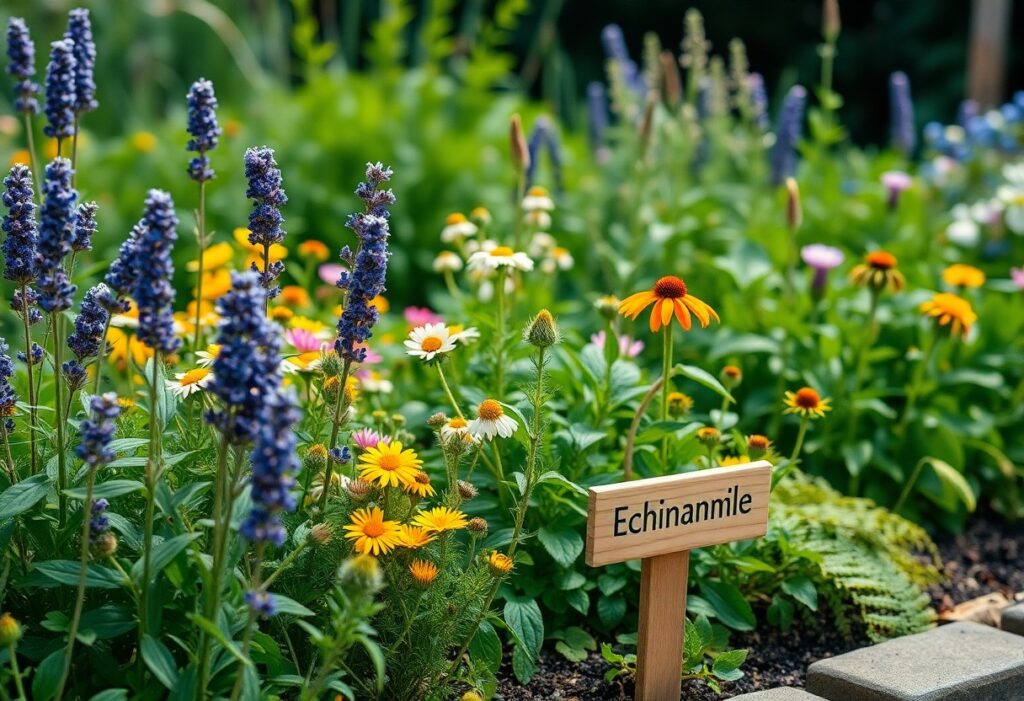With a growing awareness of natural remedies, cultivating a medicinal garden at home can empower you to access healing herbs and plants right from your backyard. This practice not only provides you with fresh ingredients for natural remedies but also enhances your knowledge of herbal medicine. As you nurture these plants, you develop a deeper connection with nature and gain the confidence to address minor ailments effectively. Discover how creating your own medicinal garden can transform your approach to health and well-being, offering a sustainable alternative in your self-care routine.

Benefits of Growing a Medicinal Garden
Enhanced Health and Wellness
Across the globe, people are increasingly recognizing the power of plants in promoting health and wellness. By cultivating a medicinal garden at home, you provide yourself access to various herbs and plants known for their healing properties. Whether it’s lavender for stress relief or echinacea for immune support, having these natural remedies at your fingertips allows you to take a proactive approach to your health. You can create your own herbal teas, tinctures, and salves tailored to your specific needs, ensuring that your wellness journey is both personally meaningful and effective.
This hands-on experience can lead to a deeper understanding of natural health alternatives, empowering you to make informed choices about your well-being. Engaging with your medicinal garden not only contributes to physical health but also fosters mental well-being. The act of growing and nurturing plants can be incredibly therapeutic, allowing you to unwind, connect with nature, and cultivate mindfulness in your daily life.
Eco-Friendly Practices
Behind the benefits to your health lies the largest advantage of a medicinal garden: promoting eco-friendly practices. By growing your own medicinal herbs, you are minimizing your reliance on commercially produced pharmaceuticals and reducing the carbon footprint associated with their transportation and packaging. Furthermore, you have the opportunity to implement sustainable gardening techniques, such as composting and organic pest control, which contribute to a healthier ecosystem.
Wellness extends beyond personal health and starts to embrace the environment as well. By nurturing a medicinal garden, you contribute to biodiversity by providing habitats for beneficial insects and foster soil health through natural cultivation methods. You can choose to cultivate native plants that require fewer resources while supporting local wildlife. This not only enhances your immediate surroundings but also aligns your gardening practices with the principles of sustainability, ensuring that your methods benefit both you and the planet.

Choosing the Right Herbs
Some people may feel overwhelmed by the vast array of herbs available for their medicinal gardens. However, with a clear understanding of your needs and goals, selecting the right herbs becomes a rewarding venture. Start by considering the ailments or health concerns you wish to address. Do you want to promote relaxation, boost immunity, or manage digestive issues? By identifying your primary objectives, you can create a targeted collection of herbs that will effectively support your family’s well-being.
Popular Medicinal Plants
At the heart of every medicinal garden are the plants that offer the most benefit to your health. Some popular choices include chamomile for its calming properties, peppermint for digestive support, and ginger for anti-inflammatory benefits. You might also consider echinacea to enhance your immune system and lavender for its soothing scent and stress-relief qualities. As you explore different options, think about incorporating a variety of herbs to ensure that your garden meets a broad range of health needs.
Climate and Soil Considerations
At the same time, understanding your local climate and soil conditions is key to a thriving medicinal garden. Different herbs have specific environmental requirements, including sunlight exposure, humidity levels, and soil type that can affect their growth. Spend a bit of time assessing your outdoor space—do you have ample sunlight, or are there shaded areas? Is your soil sandy, clayey, or loamy? This will help you make informed decisions about which herbs will flourish in your garden.
With this preliminary assessment, you can tailor your herb selection to suit your environment better. For example, if you live in a drier climate, herbs like rosemary and thyme may thrive, while cooler, wetter areas could be more suitable for plants like mint and lemon balm. Additionally, consider conducting a soil test to verify its pH and nutrient levels, allowing you to amend the soil accordingly for optimal growth. Boldly embracing your local climate and soil conditions as part of your garden plan will lead to a more fruitful and productive herbal endeavor.
Planning Your Medicinal Garden
Not every garden is created equal, especially when it comes to growing medicinal herbs. To maximize the effectiveness of your medicinal garden, you should first consider how to design it. This means taking the time to think about the layout and organization of your plants. Consider grouping herbs by their uses, such as anti-inflammatory, calming, or digestive, which will not only make harvesting easier but also enhance your learning experience as you cultivate the garden. Make sure to include paths for easy access, and allow sufficient space for each plant to grow to its full potential. Utilizing vertical space can also be beneficial, whether through trellises or hanging planters, especially if you have limited ground space. You want your garden to be both functional and aesthetically pleasing, as an enjoyable environment encourages regular care and growth.
Garden Design and Layout
Beside plant selection, you’ll want to think about how to arrange your herbs for optimal growth and maintenance. Consider creating a tiered garden or raised beds to improve drainage and sunlight exposure, ensuring the plants thrive. Different herbs may have different water and sun requirements, so take the time to research the needs of each type you plan to grow. A well-planned layout will not only boost growth but will also contribute to the overall health of your garden. Making room for companion planting can help prevent pests naturally, as certain plants can repel harmful insects while attracting beneficial ones.
Optimal Growing Conditions
Among the most important aspects of a successful medicinal garden is understanding the optimal growing conditions for your chosen plants. Factors like soil type, sunlight, water availability, and climate can greatly impact the health and effectiveness of your herbs. Most medicinal plants thrive in well-draining soil rich in organic matter, while some may prefer sandy or clay soils based on their particular growth needs. Ensuring your plants receive adequate sunlight, usually at least six to eight hours daily, is imperative for robust growth. You may also need to adjust your watering schedule based on weather conditions; keeping soil consistently moist but not waterlogged will support healthy root development.
Designing your medicinal garden with optimal growing conditions in mind also means conducting a soil test to determine pH and nutrient levels, enabling you to amend the soil as necessary for your plants. Incorporating organic compost or fertilizers can enhance soil fertility and encourage growth. Additionally, consider local climate factors such as frost dates or average rainfall patterns so you can choose the right varieties that will thrive in your specific environment. By paying attention to these details, you’ll create a productive space that meets the needs of your medicinal plants, giving you the best possible yields for your herbal remedies.
Cultivation and Care
Unlike traditional gardens that may focus solely on aesthetics, a medicinal garden requires specific attention to the needs of your herbs and plants. It is imperative to provide the right conditions for growth, including adequate sunlight, proper soil, and sufficient water. The ideal location for your medicinal garden should receive at least six hours of sunlight daily and be equipped with well-draining soil to prevent root rot. Regular watering is important, but it’s equally vital to avoid overwatering, which can lead to issues with fungal diseases.
Cultivating a medicinal garden also means being mindful of your plants’ growth habits and potential needs. Practicing crop rotation and companion planting can enhance the health of your garden and promote biodiversity. Additionally, you should pay close attention to any signs of distress in your plants, such as yellowing leaves or stunted growth, which can indicate nutrient deficiencies or environmental stress. Regularly checking and adjusting these conditions will help ensure that your medicinal plants thrive and are ready for your herbal remedies.
Planting Techniques
An effective planting technique begins with understanding the unique qualities of each medicinal plant you wish to cultivate. Before planting, it’s beneficial to research each herb’s specific needs regarding spacing, depth, and companions. For instance, some plants, like basil, prefer to be planted in groups to promote pollination and growth, while others may thrive better when spaced out to reduce competition for resources. You should also consider starting some seedlings indoors before transplanting them into your garden to give them a head start when the weather warms up.
Additionally, using organic seeds or transplants can ensure that your medicinal garden remains free from synthetic chemicals. When planting, ensure that you provide each seed or seedling with the right amount of soil cover and gently tamp down the soil to establish good soil contact. Regular watering after planting is imperative, so the seeds germinate effectively, and the young plants become established in their new environment.
Organic Pest Management
To maintain the health of your medicinal plants, developing an organic pest management plan is vital. This approach focuses on preventing pests from causing damage while using natural methods to control any infestations that may occur. You can encourage beneficial insects, such as ladybugs and lacewings, to inhabit your garden by planting diverse flowers and herbs that attract them. Additionally, using barriers like row covers can help protect your plants from pests without resorting to harmful chemicals.
Due to the nature of a medicinal garden, growing without synthetic pesticides not only safeguards your plants but also keeps your remedies free from harmful residues. By employing methods like hand-picking pests, introducing natural predators, and utilizing organic compliant insecticidal soaps or neem oil when necessary, you can manage pest populations effectively. This sustainable approach not only preserves the integrity of your medicinal herbs but also safeguards the health of your family and the surrounding ecosystem.
Harvesting and Using Your Medicinal Herbs
Despite the prior effort of nurturing your medicinal garden, the real magic happens when it’s time to harvest and utilize your herbs. Knowing how to effectively gather and prepare your herbs can elevate their potency and ensure that you maximize their health benefits. Each herb has its ideal time for harvesting, often just before flowering, when the imperative oils and active compounds are at their peak. Be attentive to the signs your plants give, as they can inform you about the best moment to collect your bounty. Take time to research specific herbs in your garden to tailor your harvesting techniques appropriately.
Best Practices for Harvesting
Any successful herbalist will tell you that harvesting practices can significantly affect the quality and efficacy of your herbs. Always use clean, sharp tools to avoid damaging the plants and to promote faster healing. When harvesting leaves, cut them just above a pair of healthy leaves, which encourages new growth. If you’re collecting flowers, choose blossoms that are fully open and vibrant, as they carry more of the beneficial properties you desire. Timing your harvesting in the early morning when plants are dew-kissed can further enhance the quality, as this is when the concentration of oils is at its highest.
Preparation Methods
Best practices for preparing your herbs involve understanding the various methods that can help you make the most of their medicinal properties. You can dry them for long-term storage or create tinctures, oils, or teas that extract their beneficial compounds. Each preparation method varies slightly in technique but generally follows simple principles. To dry herbs, hang them in small bundles in a cool, dark, and well-ventilated area, ensuring they retain quality and potency. Tinctures can be made by soaking fresh or dried herbs in alcohol or glycerin, capturing their medicinal qualities in a potent liquid that can last for years.
Considering the variety of preparation methods available, you can choose those that best fit your lifestyle and intended use. For instance, if you prefer immediate access to your herbs, perhaps brewing a fresh tea will be ideal. Alternatively, if you want to maximize shelf life and potency, consider tinctures. Each method will extract different properties from the herbs, so experimenting can help you discover the best practices for your personal health needs and preferences. With time and experience, you’ll become adept at harvesting and preparing your medicinal herbs to enhance your overall well-being.
Legal and Safety Considerations
Understanding Local Regulations
About the legal landscape surrounding medicinal herbs, you must familiarize yourself with the specific regulations in your area. Many regions have different laws governing the cultivation, possession, and usage of medicinal plants. Some herbs may be entirely legal to grow for personal use, while others may come with restrictions or require a permit. Researching local laws will ensure that you are compliant and protect you from potential legal issues.
It’s also advisable to connect with local gardening clubs or online forums, as they can provide valuable insights into the nuances of local regulations. This not only enriches your knowledge but also helps you understand community standards and practices regarding growing medicinal plants. Being aware of your rights and obligations is an imperative first step toward creating a safe and compliant medicinal garden.
Safety Precautions
By embracing safety precautions, you can create a thriving and secure environment for your medicinal garden. While many medicinal plants are safe, some can cause allergic reactions or interactions with medications. Consult with a healthcare professional to ensure that the herbs you are considering growing won’t adversely affect your health or that of family members.
Furthermore, practicing good gardening hygiene, such as wearing gloves when handling plants and washing your hands thoroughly after gardening, is imperative. Avoid ingesting any plant without proper identification and knowledge of its effects. Educating yourself on safe harvesting, storage, and preparation methods will also significantly reduce risks associated with your medicinal garden.
With these safety measures, you can enjoy the enriching experience of cultivating a medicinal garden while minimizing risks. It’s also beneficial to keep a detailed inventory of the plants you grow, noting their uses and potential side effects. This practice not only enhances your understanding but also serves as a valuable reference if you ever need to consult a medical professional about your plants or their usage.
To wrap up
On the whole, growing a medicinal garden at home offers numerous advantages that can enhance your health and well-being. By cultivating plants known for their healing properties, you gain immediate access to natural remedies for various ailments right in your backyard or balcony. This not only empowers you with self-sufficiency in managing mild health issues but also fosters a deeper understanding of the power of nature. As you tend to your garden, you engage in a nurturing process that can reduce stress, promote relaxation, and encourage healthier lifestyle choices.
Moreover, establishing a medicinal garden serves as an educational journey for you and your family, as you learn to identify, harvest, and utilize various herbs and plants effectively. It cultivates an appreciation for nature and encourages sustainable practices. You can also share your knowledge and produce with your community, promoting a greater awareness of herbal remedies. By embracing this gratifying endeavor, you not only enrich your own life but also contribute positively to your surroundings, making it a wise and fulfilling investment in your future well-being.
FAQ
Q: What are the benefits of growing a medicinal garden at home?
A: Growing a medicinal garden at home provides numerous advantages. It allows easy access to fresh herbs and plants that can be used for natural remedies, potentially reducing dependence on commercial medications. Additionally, gardening can be a therapeutic activity that promotes mental well-being and relaxation. You also gain a deeper understanding of the healing properties of various plants, enabling you to make informed choices about health and wellness.
Q: Which herbs are best suited for a home medicinal garden?
A: Some of the best herbs for a home medicinal garden include chamomile (for relaxation), mint (for digestive issues), lavender (for stress relief), and echinacea (to boost the immune system). Other popular options are rosemary, thyme, and lemon balm, all known for their medicinal benefits. It’s important to choose herbs based on your individual health needs and the climate in your area.
Q: How can I maintain a medicinal garden effectively?
A: Maintaining a medicinal garden effectively involves regular watering, proper sunlight exposure, and ensuring healthy soil. It’s vital to keep an eye out for pests and diseases, using organic methods for control when possible. Regular pruning and harvesting can encourage growth and vitality in the plants. Educating yourself about the specific needs of each herb will greatly aid in your garden’s success.
Q: Can I use medicinal herbs for cooking and culinary purposes?
A: Yes, many medicinal herbs have culinary uses and can enhance the flavor of your dishes. Herbs like basil, oregano, and parsley not only contribute to meals but also provide health benefits. Incorporating medicinal herbs into your cooking allows you to enjoy their flavors while reaping their medicinal properties, making your meals both tasty and nutritious.
Q: Are there any safety concerns with growing medicinal plants at home?
A: While many medicinal plants are safe to grow and use, it’s important to research and understand each plant’s properties and potential interactions with other medications. Some plants may have side effects or be unsuitable for certain conditions. Consulting with a healthcare professional before using medicinal herbs, especially if you are pregnant, nursing, or on medication, can help ensure safe use.


